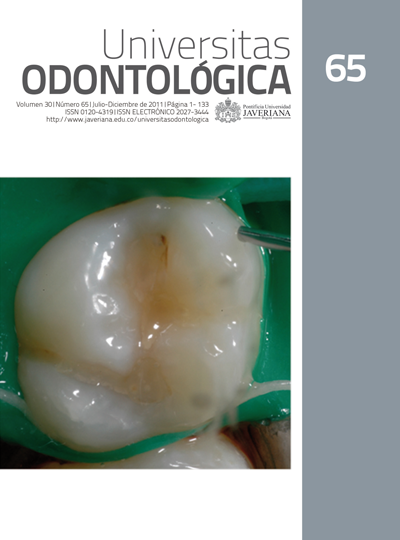Abstract
Antecedentes: los cementos de resina acrílica se han utilizado durante más de cincuenta años en las diferentes áreas de la odontología; sin embargo, la aplicabilidad clínica de las nuevas formulaciones específicas para ortodoncia aún está por determinarse. Objetivo: comparar la fuerza y el tipo de falla adhesiva de dos tipos de resinas cementantes para ortodoncia. Métodos: Se dividieron aleatoriamente veinticuatro primeros premolares superiores en dos grupos: doce para el grupo de resina compuesta (Transbond® XT, 3M Unitek, St. Paul, Minnesota, EE. UU.) y doce para el grupo de resina acrílica (Orthomite® Sun Medical, Miroyama, Japón). A estos dientes se les cementaron brackets estándar (Ortho Organizers, California, EE. UU.) y después de veinticuatro horas fueron sometidos a 5000 ciclos térmicos. Posteriormente se aplicó una fuerza de corte (velocidad 1,5 mm/min) en la interfase bracket-esmalte utilizando un dispositivo universal de pruebas (Instron®). Los datos fueron calculados en megapascales, dividiendo la fuerza por el área de la base del bracket. Finalmente, a fin de determinar el tipo de falla, las superficies de los dientes y las bases de los brackets, se analizaron utilizando un estereomicroscopio (Stemi 2000C, Carl Zeiss, Göttingen, Alemania). Resultados: en cuanto a fuerza adhesiva, la resina compuesta presentó mayores valores que la resina acrílica (21,4 MPa vs. 18,4 MPa), sin ser esta una diferencia estadísticamente significativa (p > 0,05). El tipo de falla predominante fue en la interfase resina-resina (92% y 58%, respectivamente). Conclusión: la fuerza adhesiva de ambos cementantes fue similar; por lo tanto, ambos materiales podrían ser recomendados para la cementación de brackets en ortodoncia.
This journal is registered under a Creative Commons Attribution 4.0 International Public License. Thus, this work may be reproduced, distributed, and publicly shared in digital format, as long as the names of the authors and Pontificia Universidad Javeriana are acknowledged. Others are allowed to quote, adapt, transform, auto-archive, republish, and create based on this material, for any purpose (even commercial ones), provided the authorship is duly acknowledged, a link to the original work is provided, and it is specified if changes have been made. Pontificia Universidad Javeriana does not hold the rights of published works and the authors are solely responsible for the contents of their works; they keep the moral, intellectual, privacy, and publicity rights.
Approving the intervention of the work (review, copy-editing, translation, layout) and the following outreach, are granted through an use license and not through an assignment of rights. This means the journal and Pontificia Universidad Javeriana cannot be held responsible for any ethical malpractice by the authors. As a consequence of the protection granted by the use license, the journal is not required to publish recantations or modify information already published, unless the errata stems from the editorial management process. Publishing contents in this journal does not generate royalties for contributors.


